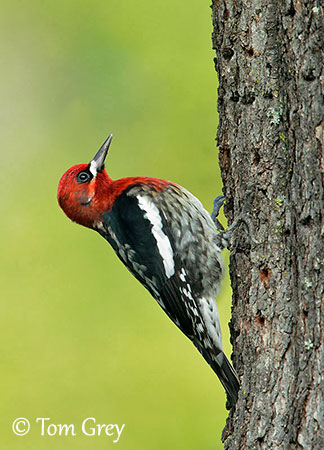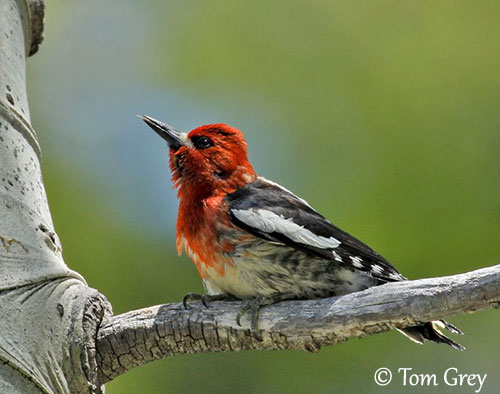
Fr: Pic à poitrine rouge
Ang: Red-breasted Sapsucker
All: Feuerkopf-Saftlecker
Esp: Chupasavia Pechirrojo
Ita: Picchio pettorosso
Nd: Roodborstsapspecht
Sd: rödhuvad savspett
Photographer:
Tom Grey
Tom Grey's Bird Pictures & Tom Grey's Bird Pictures 2
Text by Nicole Bouglouan
Sources:
HANDBOOK OF THE BIRDS OF THE WORLD Vol. 7 by Josep del Hoyo-Andrew Elliott-Jordi Sargatal – Lynx Edicions – ISBN: 8487334377
WOODPECKERS, an identification guide of the woodpeckers of the world by Winkler Hans and Christie David – Helm – ISBN: 0395720435
FIELD GUIDE TO THE BIRDS OF NORTH AMERICA - National Geographic Society - ISBN: 0792274512
About.com – Birding / Wild Birds
Red-breasted Sapsucker Sphyrapicus ruber
Green Timbers Heritage Society
Atlas of the Breeding Birds of British Columbia
Animal Diversity Web (University of Michigan Museum of Zoology)
Bird Web (Seattle Audubon Society)
South Dakota Birds and Birding – (Terry L. Sohl)
What Bird-The ultimate Bird Guide (Mitchell Waite)
Wikipedia, the free encyclopaedia
Red-breasted Sapsucker
Sphyrapicus ruber
Piciformes Order – Picidae Family
INTRODUCTION:
The Red-breasted Sapsucker of genus Sphyrapicus is now a full species in the large family Picidae.
This species is a medium-sized colourful sapsucker. It is found year-round along the Pacific coast from S Alaska to N California. Two subspecies share this range.
It usually frequents moist forests with coniferous or mixed-coniferous/deciduous trees. It primarily feeds on sap accumulated in holes, giving this bird its English name “sapsucker”. But it also consumes berries and fruits, insects, caterpillars and spiders.
The Red-breasted Sapsucker is monogamous during the breeding season. It typically nests in a cavity excavated by both mates in dead tree or dead branch in live tree. Both adults share all the nesting duties.
The Red-breasted Sapsucker is probably affected by habitat loss involving some decline, but currently, the species is not globally threatened.

DESCRIPTION OF THE BIRD:
Biometrics:
Length: 20-22 cm
Wingspan: 37-41 cm
Weight: 53-63 g
The Red-breasted Sapsucker has red head, nape, throat and breast.
On the upperparts, the back is black with variable yellow and white spotting. The black wings show a conspicuous white slash-like patch along the edge. The rump is white. On the pointed tail, the outer rectrices are black, whereas the inner ones are white with black bars.
On the underparts, the belly is yellow to whitish-yellow with narrow black streaks on flanks. The undertail-coverts are white with black streaks. The vent may be greyish to yellowish.
On the red head, we can see a black spot in front of the eye, and a white line from lore to nostril.
The bill is black. The eyes are dark brown. Legs and feet are greyish.
Male and female are similar.
The juvenile has first brownish plumage until moulting in early fall. Then, the brown colour is replaced by red and black adult plumage. The eyes are greyish-brown.
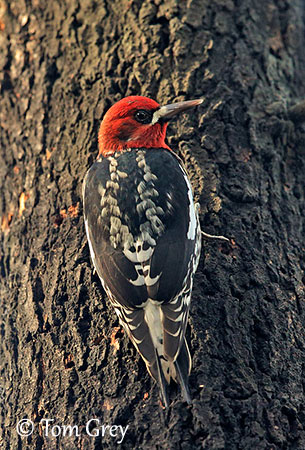
SUBSPECIES AND RANGE:
The Red-breasted Sapsucker has two recognized subspecies.
S. r. ruber (described above) is found in coastal S Alaska to W Oregon.
S. r. daggetti (displayed) occurs in SW Oregon to Sierra Nevada of S California and W Nevada.
This race resembles nominate but with slightly duller and more orange-red colour on head and breast. It is slightly smaller than nominate.
On the head, nasal tufts and front of lores are white and extend as a broad malar stripe of variable length. We can also see a small, black area in front of the eye and below it.
In worn plumage in summer, the red colour may be very bright, although some black bases may appear through crown and breast feathers.
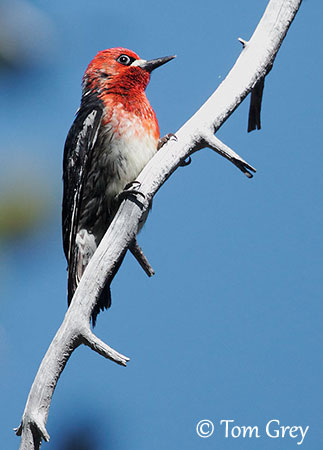
HABITAT:
The Red-breasted Sapsucker living in coastal regions usually frequents humid conifer forests. Elsewhere, it is found in mixed deciduous/coniferous forests and forest edges. But it also frequents orchards and second-growth woodlands.
It breeds near sea-level up to 2,900 metres of elevation in coniferous forest.
During winter, it moves to wooded areas, frequents parks and suburbs, coastal areas and lower elevations around 500 metres. But at this period, it can be seen between 500 and 3,000 metres of elevation.
CALLS AND SONGS: SOUNDS BY XENO-CANTO
The sounds given by the Red-breasted Sapsucker are probably similar to Red-naped Sapsucker and Yellow-bellied Sapsucker.
It produces a mewing, drawn-out “meeah” and also quiet “pue” or “pwue” notes. If disturbed, it gives a “waa” call commonly repeated and declining progressively in frequency.
Both sexes drum, consisting of an initial burst followed by irregular, slower burst of 2-3 strokes.
BEHAVIOUR IN THE WILD:
The Red-breasted Sapsucker is named for its primary method of feeding behaviour. It drills small holes in the bark in spaced rows and returns periodically to them to feed on the sap that oozes out.
But it also consumes insects attracted to the sap, gleaning them from tree trunks like all Picidae. It may also sally out to catch them in the air. Berries, fruits, spiders, caterpillars and mayflies are also part of the diet.
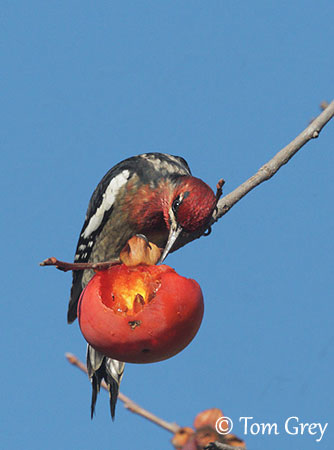
The Red-breasted Sapsucker is monogamous during the breeding season. It is very territorial and defends strongly the nest-site. Some courtship displays have been described, during which the bird is swaying from side to side while pointing the bill up, probably to enhance the red colour of head and breast.
As usual in this family, it is a cavity-nester and both mates excavate the hole. The same tree may be used in several following years, but not the same cavity. Both parents share the nesting duties.
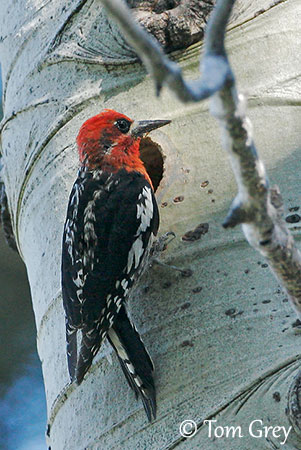
In Pacific Northwest, the Red-breasted Sapsucker from the interior moves to the coast or southwards, but the coastal birds are often resident (nominate race S.r. ruber).
The southern populations perform altitudinal movements and move to lower elevations throughout California and NW Baja California (race S.r. daggetti).
The flight of the Red-breasted Sapsucker is typically undulating. The bird alternates rapid wingbeats and short glides.
REPRODUCTION OF THIS SPECIES:
The Red-breasted Sapsucker lays a single brood per season. The laying takes place from April to July. A replacement clutch is probably laid if the first brood is lost.
The nest-site is often in deciduous tree, but also sometimes in conifer. Both adults excavate the cavity, and this work may last 2-4 weeks. The hole is excavated between 15 and 50 metres above the ground. Only a few wood chips may remain in the cavity, without other nesting material.
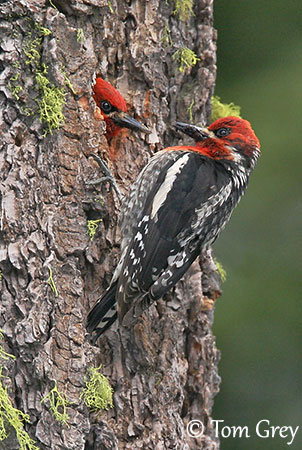
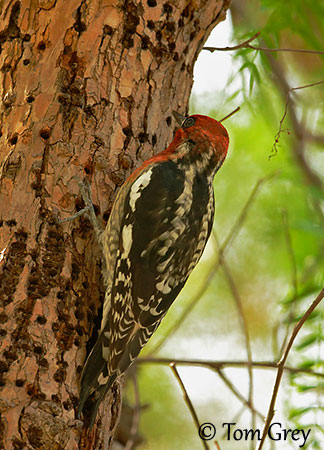
The female lays 4-7 white eggs, and both adults incubate during 11-15 days. The chicks are fed with insects, sap and fruit. They leave the nest 23-28 days after hatching. They are fed for about 10 days after leaving the nest, and their parents teach them the sapsucking feeding habit.
The Red-breasted Sapsucker easily hybridizes with both Red-naped Sapsucker and Yellow-bellied Sapsucker when their ranges overlap.
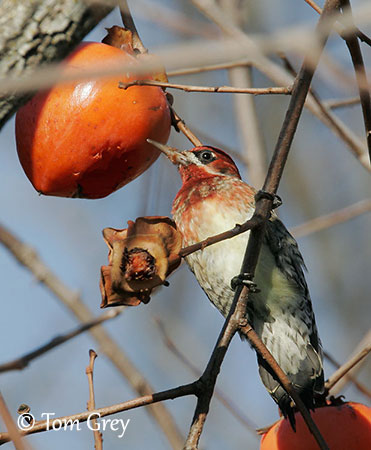
PROTECTION / THREATS / STATUS:
The Red-breasted Sapsucker is probably affected by habitat loss through logging activities and snag removal, but it is also persecuted as orchard pest because the sap well drilling may kill the fruiting trees.
The population is estimated to number 2,300,000 mature individuals, and it is suspected to be declining.
But the Red-breasted Sapsucker is not globally threatened and the species is currently evaluated as Least Concern.
